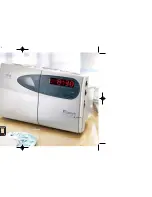
13
8.
HOME and Sel Buttons
Press HOME to go to the radio’s preprogrammed
HOME mode. Press HOME instead of Mode to change
modes. Hold HOME until a beep sounds to enter the
configuration state. The display shows an entry prompt.
Use the keypad to enter your new mode choice and
press HOME again. The mode is now changed without
scrolling.
Use the Sel button when configuring an option. See
the descriptions of the options for more specific informa-
tion.
9.
DIM Button
Above the keypad, on the right side of the control
unit, is the control for the brightness of the display and
button backlighting. When you turn on the system, the
display comes on at the highest level. Press DIM once
to reduce the brightness of the display to medium level,
and twice for low brightness level. Press DIM a third
time to turn the display and button backlighting off. This
is called the surveillance mode.
10. Keypad
The keypad is for changing the status of options
and entering numbers to the display. See the Opera-
tor’s Manual for a complete description of button
operation.
B. Theory of Operation
1.
General
The Spectra 9000 control unit has solid state micro-
processor circuitry that operates the standard and
optional features built into the system. The control unit
design allows installation in even the smallest of down-
sized vehicles. Systems that have many options simply
require more control unit buttons, not larger control
units.
The control unit may be field programmed to alter
the information stored in certain areas of its electronic
memory. Some options are also added by field pro-
gramming.
2.
Display
The control unit has an 11-character alphanumeric
vacuum fluorescent display for indicating the following:
• Mode Names
• Squelch Level
• Volume Level
• Status Codes
• Message Codes
• Telephone Numbers
• Identification Numbers
• Alarm Displays
• Option Status
3.
Controls and Indicators
A 12-button keypad contains traditional alphanu-
meric keys. These keys double as function keys for
radio options. All buttons are backlit to allow operation
in low light. Six ON/OFF option buttons and indicator
lights above the display window tell whether these
options are on or off.
Other indicators include BUSY, XMIT, PRI, and
NON-PRI. BUSY lights when activity is detected on the
channel. The XMIT (transmit) indicator lights when
transmitting.
When activity occurs during a scan sequence, the
NON-PRI (non-priority) or PRI (priority) light is on. If the
detected activity is on a NON-PRI mode, the NON-PRI
light is on. If the activity is on PRI mode, the PRI indica-
tor lights for second-priority modes, and flashes for
first-priority modes.
4.
Control Board
The control board’s microprocessor (MPU) commu-
nicates on the serial bus, receives and interprets keypad
data, and controls the volume. The MPU sends ASCII
data to a decoder to control the display, and sends data
to turn the LEDs on or off. The control board has a
watchdog timer that senses the need for a system reset.
The vehicle interface ports are also controlled on this
board.
5.
Microprocessor (MPU)
The MPU operates in mode 2 (expanded bus with
internal ROM active). Table 5 gives jumper placements
for different modes. The clock frequency is 4.9152
MHz that results in an internal operating frequency of
1288 kHz. The limited number of I/O ports is augment-
ed by using a serial-to-parallel shift register (U3) to scan
the keyboard, and to switch the VIP drivers (Q28, Q29,
Q30, and Q33).
6.
Watchdog Timer
The watchdog timer consists of U5 (comparator)
and Q4 (SCR). On system power-up, C06 pulls the
inverting input of U5 high, while R10 and R11 hold the
non-inverting input at VCC/2. The output goes low and
the microprocessor resets.
As C06 charges through R14, the voltage on the
inverting input drops below that of the non-inverting
input, the output goes high, and the microprocessor can
start operating. R14 is now pulling up on C06, and the
inverting-input voltage begins to rise.
Microprocessor Mode
JU3
JU6
No. 1–Expanded mode with external ROM only.
IN
OUT
No. 2–Expanded mode with internal ROM active.
OUT
IN
No. 3–Single Chip
OUT
OUT
Table 5. Mode Jumper Placement
Содержание Spectra
Страница 6: ...v PERFORMANCE SPECIFICATIONS FOR SPECTRA PRIVACY PLUS TRUNKED CONVENTIONAL 900 MHz RADIO ...
Страница 7: ...vi PERFORMANCE SPECIFICATIONS FOR SPECTRA SMARTNET TRUNKED CONVENTIONAL 900 MHz RADIO ...
Страница 8: ...vii PERFORMANCE SPECIFICATIONS FOR SPECTRA 9000 RADIOS 900 MHz 30 WATTS ...
Страница 25: ...1 GENERAL INFORMATION 1 ...
Страница 73: ...53 INSERT GPW 7221 B Figure 22 Front Panel Diagnostics Key Closure Displays ...
Страница 75: ...INSERT GXW 4278 O PICKUP FROM PW 4320 O 55 CONTROL STATION WIRING DIAGRAM ...
Страница 79: ...PUSHBUTTON SPECTRA 900 MHz RADIO MECHANICAL EXPLODED VIEW 59 INSERT GXW 6225 B ...
Страница 96: ...82 MECHANICAL EXPLODED VIEW PARTS LIST FOR SPECTRA 900 MHz RADIO ...
















































